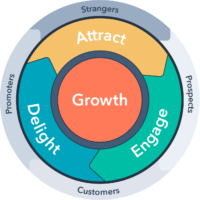You may be familiar with the lead generation concept of the funnel, where the lead generation process is described with a linear focus, moving prospects from awareness to engagement to conversion where they become customers. In 2020, HubSpot, a leading marketing software company, developed the concept of the flywheel as the successor to the funnel concept.
The flywheel concept is not only far more relevant to today’s consumers; it’s exactly what the accounting and tax profession should be using in business development.
In the old funnel model, marketing and sales functions were complete once the sale was made. The funnel didn’t take into account client retention, client referrals, or customer service, which many firms struggle with.
The flywheel idea puts the client at the center. Today’s consumer is constantly researching and continually skeptical. They are evaluating you and your services before and after their purchase. They are evaluating their experience with you to determine if they want to be your advocate or not.
The flywheel implies a rotating, or spinning, process, where individuals enter the circle at various points depending on whether they are strangers to you, prospects, customers, or promoters. Your goal varies, from attracting to engaging to delighting, depending on where they are in the process.
Your relationship with your clients is key, and it’s constantly evolving. The key to business development growth for accounting firms is to focus not only on lead generation, but to create a continual experience for the client that exceeds their expectations.
How fast your flywheel spins depends upon your strategies. HubSpot says the key is to reduce friction at the points you want to grow. You do that by focusing on customer needs and making it easy for them to learn about what you offer.
In the Attraction phase this can mean developing great content that describes your value and your offerings. Content can be pushed out through many different marketing channels, such as paid ads, SEO, social media, and more. It’s about earning people’s attention, not forcing it.
In the Engagement phase, you are starting and developing the relationship, so you want to make it easy to interact with you. This may include lead nurturing, marketing automation, an initial consult, and/or lots and lots of educational and support videos.
In the Delight phase, you’re helping the client reach their goals. This is where advisory work beyond compliance can make such a difference. From a marketing standpoint, this means exceptional customer service, encouraging clients to leave online reviews, and/or customer loyalty and referral programs.
As HubSpot’s blog says, “the biggest threat to your company’s growth isn’t your competitors. It’s a bad customer experience.” And while I realize staffing is our number one block to growth in the tax and accounting profession right now, this gives us an opportunity to improve in two areas of our business: automation and customer service.
When a client can seamlessly get their needs met through smooth automation of as many client touchpoints as possible, it improves the experience and increases client retention and referrals. Similarly, when employees are trained in customer service – and for most of us, it’s a learned skill, not a natural skill – then client retention and referrals increase, too.
Take a look at the flywheel versus the funnel to determine how you can propel growth in your firm. And, if you’d like to do further reading, here is a link the original Flywheel article from HubSpot.


